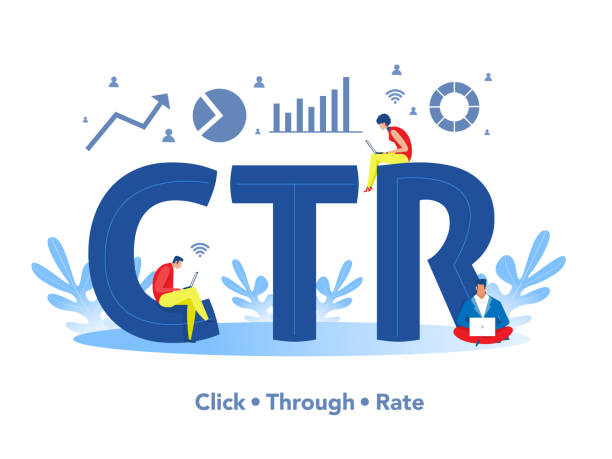

Click-through rates (CTRs) are a crucial metric in the world of digital marketing. They measure the success of an online advertisement or link by tracking how many users click on it. Understanding the importance of CTRs is essential for any business looking to drive traffic and increase conversions.
One key reason why CTRs are so important is that they directly impact a website's visibility and ranking in search engine results. Search engines like Google use CTRs as a factor in determining which websites are most relevant and valuable to users. A high CTR indicates that users find the content engaging and useful, which can improve a website's overall search engine optimization (SEO) performance.
In addition, CTRs play a significant role in measuring the effectiveness of advertising campaigns. By tracking how many users click on an ad, marketers can assess its performance and make adjustments to optimize results. A low CTR may indicate that an ad is not resonating with its target audience, prompting changes to be made to improve engagement.
Given the importance of CTRs, some businesses may resort to manipulation methods to artificially inflate their click-through rates. This unethical practice involves tactics such as click farms, where fake accounts are used to generate clicks, or misleading advertisements designed solely to entice clicks without delivering value. While these methods may temporarily boost CTRs, they ultimately harm a business's reputation and credibility.
To ensure ethical marketing practices and genuine engagement with audiences, businesses should focus on creating compelling content that resonates with users and drives organic clicks. By understanding the true significance of click-through rates and implementing effective strategies to boost them authentically, businesses can achieve sustainable growth and success in today's competitive digital landscape.
Click-Through Rate (CTR) manipulation is a practice that some individuals or organizations engage in to artificially inflate the number of clicks on a particular link or advertisement. This can be done through various methods, with Black Hat techniques being the most unethical and frowned upon.
Black Hat methods for manipulating CTRs often involve tactics such as click farms, bots, or automated scripts that generate fake clicks on a website or ad. These practices are deceptive and can have serious consequences for both advertisers and users. Not only does it violate the terms of service of most online platforms, but it can also lead to wasted advertising dollars and damage to a brand's reputation.
Furthermore, manipulating CTRs through Black Hat methods does not provide any real value to users. It distorts the true performance metrics of a campaign and can ultimately undermine the trust that users have in online advertising.
It is important for businesses and marketers to prioritize ethical practices when it comes to CTR manipulation. By focusing on creating engaging content and providing valuable experiences for users, they can build genuine relationships with their audience and drive sustainable growth over time.
In conclusion, Black Hat methods for manipulating CTRs may offer short-term gains, but they come at a high cost. It is far more beneficial in the long run to focus on building authentic connections with users and delivering quality content that resonates with them.
In the world of digital advertising, one of the most important metrics to track and improve upon is the click-through rate (CTR).. The CTR measures the effectiveness of an ad by showing how many people actually clicked on it after seeing it.

Posted by on 2024-05-03
As advertisers continue to invest in Google Ads campaigns, the issue of click-through rate (CTR) manipulation has become a growing concern.. CTR manipulation refers to the practice of artificially inflating the number of clicks on an ad to boost its performance metrics, such as CTR and conversion rates.

Posted by on 2024-05-03
Click-through rate (CTR) manipulation is a common practice in online advertising campaigns that can have a significant impact on overall campaign performance and return on investment (ROI).. When advertisers artificially inflate their CTR by clicking on their own ads or using bots to generate clicks, they may appear to be driving more traffic to their website or landing page.

Posted by on 2024-05-03
Click-through rates (CTRs) are a crucial metric in digital marketing that measure the percentage of users who click on a specific link, advertisement, or call-to-action.. A high CTR indicates that your content is engaging and relevant to your target audience, while a low CTR could mean that your message is not resonating with users.
There are several strategies you can utilize to skyrocket your CTRs through manipulation tactics.

Posted by on 2024-05-03
CTR manipulation, also known as click-through rate manipulation, is a powerful tool that can greatly impact the success of your online marketing campaigns.. By strategically increasing the number of clicks on your ads or website links, you can effectively boost your ROI and drive more traffic to your site.
When you unleash the power of CTR manipulation, you are essentially taking control of how users interact with your content.

Posted by on 2024-05-03
When it comes to improving click-through rates for your website or online content, it's important to focus on using ethical and White Hat methods. These methods are not only effective in increasing CTR but also ensure that you are following the guidelines set by search engines and maintaining a positive reputation.
One of the key White Hat methods for improving click-through rates is creating high-quality, relevant content. By providing valuable information that is engaging and informative, you are more likely to attract clicks from users who are genuinely interested in what you have to offer. This can help increase your CTR organically and build trust with your audience.
Another important White Hat method is optimizing your meta tags and descriptions. By including keywords that are relevant to your content and accurately describing what the page is about, you can improve visibility in search engine results and encourage users to click through to your site.
Additionally, utilizing social media platforms to promote your content can also help improve click-through rates. By sharing links to your website or blog posts on social media channels where your target audience is active, you can reach a wider audience and drive more traffic to your site.
Overall, using White Hat methods for improving click-through rates not only helps boost engagement with your content but also ensures that you are building a sustainable online presence that follows best practices. By focusing on providing value to users and optimizing your content effectively, you can see significant improvements in CTR over time while maintaining a positive reputation online.
Click-Through Rate (CTR) manipulation is a practice that involves artificially boosting the number of clicks on a particular link or advertisement in order to deceive algorithms and users into thinking it is more popular than it actually is. While this may seem like a harmless tactic to increase visibility and traffic, there are significant risks and consequences associated with engaging in CTR manipulation.
One of the main risks of CTR manipulation is that it can lead to a loss of trust and credibility among users. When users click on a link expecting to find valuable content or products, only to be misled by inflated CTR numbers, they are likely to feel deceived and manipulated. This can result in negative feedback, decreased engagement, and ultimately damage the reputation of the website or advertiser.
Furthermore, engaging in CTR manipulation can also have serious consequences for search engine rankings and advertising platforms. Algorithms are designed to detect fraudulent activity such as click farms or bot networks that artificially inflate CTR numbers. Once detected, websites or advertisers may face penalties such as being removed from search results or having their accounts suspended.
In addition, CTR manipulation can also lead to financial repercussions for advertisers who may be paying for clicks that do not result in genuine leads or conversions. This can waste valuable resources and diminish the return on investment for advertising campaigns.
Overall, while CTR manipulation may seem like a quick fix for increasing visibility and traffic, the risks and consequences far outweigh any potential benefits. It is important for businesses and advertisers to prioritize transparency, authenticity, and ethical practices in order to build trust with users and maintain long-term success online.
Click-through rate manipulation is a common practice in the digital marketing world, and case studies of successful manipulation can provide valuable insights for marketers looking to improve their own click-through rates. By studying these cases, we can learn about the various methods that have been used to effectively increase click-through rates and drive more traffic to websites.
One of the key strategies that has been employed in successful click-through rate manipulation is A/B testing. By creating multiple versions of an ad or landing page and testing them against each other, marketers can identify which elements are most effective at driving clicks. This allows them to make data-driven decisions about how to optimize their campaigns for maximum success.
Another effective method for manipulating click-through rates is through the use of compelling visuals and messaging. By creating eye-catching graphics and writing engaging copy, marketers can capture the attention of their target audience and entice them to click on their ads. This approach has been proven to be highly effective in increasing click-through rates and generating more leads for businesses.
Additionally, leveraging social proof and testimonials can also be a powerful way to boost click-through rates. By showcasing positive reviews from satisfied customers or highlighting endorsements from influencers in the industry, marketers can build trust with potential customers and encourage them to take action.
In conclusion, case studies of successful click-through rate manipulation demonstrate the importance of using data-driven strategies, compelling visuals and messaging, as well as social proof to drive more traffic to websites. By learning from these examples, marketers can implement similar tactics in their own campaigns and achieve higher levels of success in reaching their target audience.
When it comes to increasing click-through rates organically, there are a few best practices that can help drive more traffic to your website or content.
One important factor to consider is the quality of your content. High-quality, relevant content is more likely to attract clicks from users who are genuinely interested in what you have to offer. Make sure your headlines are compelling and accurately reflect the content of your page, as misleading headlines can lead to high bounce rates and lower click-through rates.
Another effective strategy for increasing click-through rates organically is optimizing your meta tags and descriptions. Meta tags provide search engines with information about the content of your page, while meta descriptions give users a preview of what they can expect when they click on your link. By including relevant keywords in your meta tags and creating engaging meta descriptions, you can improve your chances of attracting clicks from users searching for related topics.
Additionally, incorporating internal links within your content can help increase click-through rates by directing users to other pages on your website that may be of interest to them. This not only keeps users engaged with your site but also improves overall user experience.
In conclusion, by focusing on creating high-quality content, optimizing meta tags and descriptions, and utilizing internal linking strategies, you can effectively increase click-through rates organically. These best practices will not only drive more traffic to your website but also help build credibility with both users and search engines.